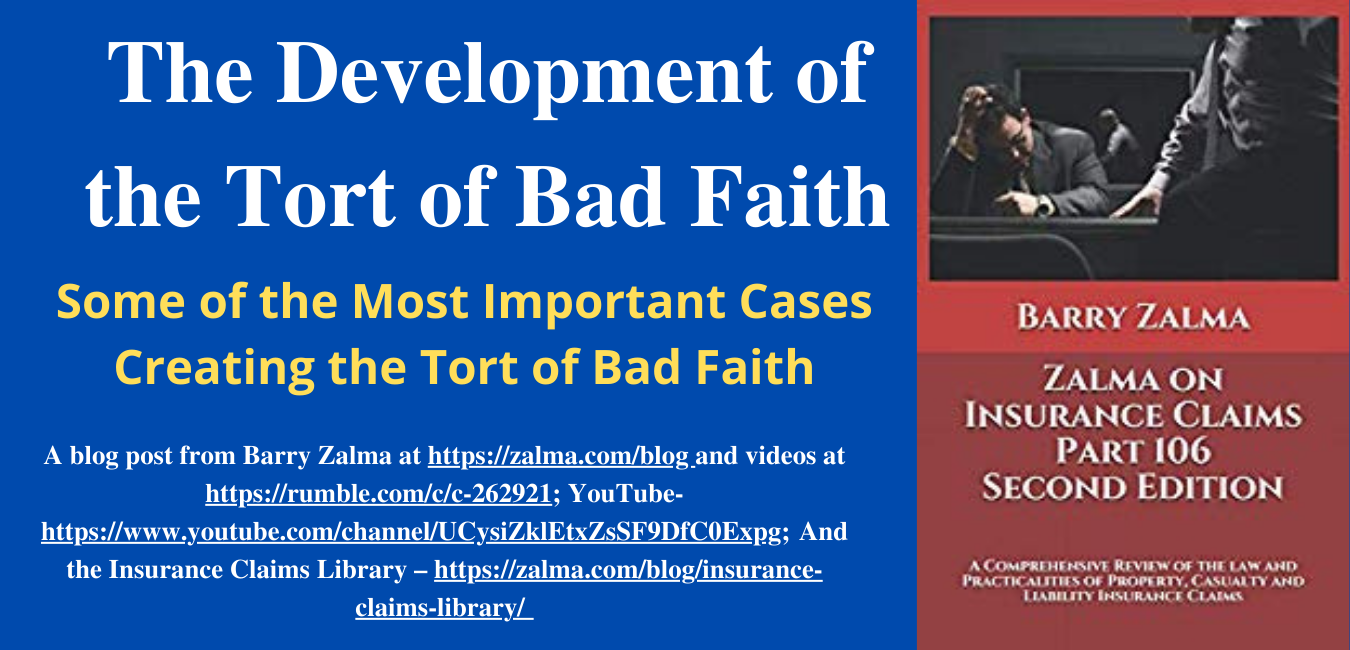-
News Feed
- EXPLORE
-
Pages
-
Groups
-
Events
-
Blogs
-
Marketplace
-
Offers
-
Jobs
-
Developers
A Video Explaining the Development of the Tort of Bad Faith

A Video Explaining The Development of the Tort of Bad Faith
Read the full article at https://www.linkedin.com/pulse/development-tort-bad-faith-barry-zalma-esq-cfe and see the full video at https://rumble.com/c/c-262921 and at https://youtu.be/QED5bIWGbYc and at https://zalma.com/blog plus more than 3850 posts.
Some of the Most Important Cases Creating the Tort of Bad Faith
In Comunale v. Traders & Gen. Ins. Co., 50 Cal. 2d 654 (1958), the insurance company wrongfully refused to defend its insured who had been sued in the underlying action for damages arising out of an automobile accident. It also refused to conclude the suit after receiving an offer of settlement for about 25 percent of the ultimate judgment obtained against its insured. The refusal resulted in an excess judgment against its insured. In the subsequent bad faith action the insurer was held liable for the entire judgment including the excess limits and other resulting damages. This was clearly an extra-contractual recovery since under a straight breach of contract claim the insurer would have been liable for only the amount of the policy.
Critz v. Farmers Ins. Group, 230 Cal.App.2d 788, 799, 41 Cal.Rptr. 401 (1964), an injured person who had recovered a judgment against an insured brought an action, as assignee of the insured, against the insurer. T
In Silberg v. California Life Ins. Co., 11 Cal. 3d 452 (1974), the insurer advertised an accident policy with the phrase “Protect Yourself Against the Medical Bills That Can Ruin You.” It issued an accident policy to Mr. Silberg.
In Egan v. Mutual of Omaha, Between 1962 and 1970, Michael Egan injured his back several times in the course of his employment and received small amounts of benefit payments pursuant to his disability policy. The claims manager called Egan a fraud. After cutting off his payments the claims staff of Mutual of Omaha continued to harass Egan in an attempt to get him to turn in his disability policy.
ZALMA OPINION
It is important that everyone involved in insurance claims understand that the tort of bad faith exists and must be dealt with whenever a claims is investigated and attempts to settle fail. The insurance claim professional can learn to avoid the mistakes made by their predecessors who cause the creation of the tort by not treating their insureds fairly and in good faith, and sometime by attempting to defraud or hurt their insureds to avoid payment of legitimate claims. Because of the creation of the tort of bad faith such wrongful conduct is rare but still exists and needs to be removed from the industry.
We are 100% funded for October.
Thanks to everyone who helped out. 🥰
Xephula monthly operating expenses for 2024 - Server: $143/month - Backup Software: $6/month - Object Storage: $6/month - SMTP Service: $10/month - Stripe Processing Fees: ~$10/month - Total: $175/month
- Art
- Causes
- Crafts
- Crime
- Dance
- Drinks
- Film
- Finance
- Fitness
- Food
- Games
- Gardening
- Health
- Home
- Literature
- Music
- Networking
- Paranormal
- Other
- Politics
- History
- News
- Party
- Science
- Religion
- Shopping
- Sports
- SyFy
- Politically Incorrect
- Philosophy
- Theater
- Technology
- Wellness



